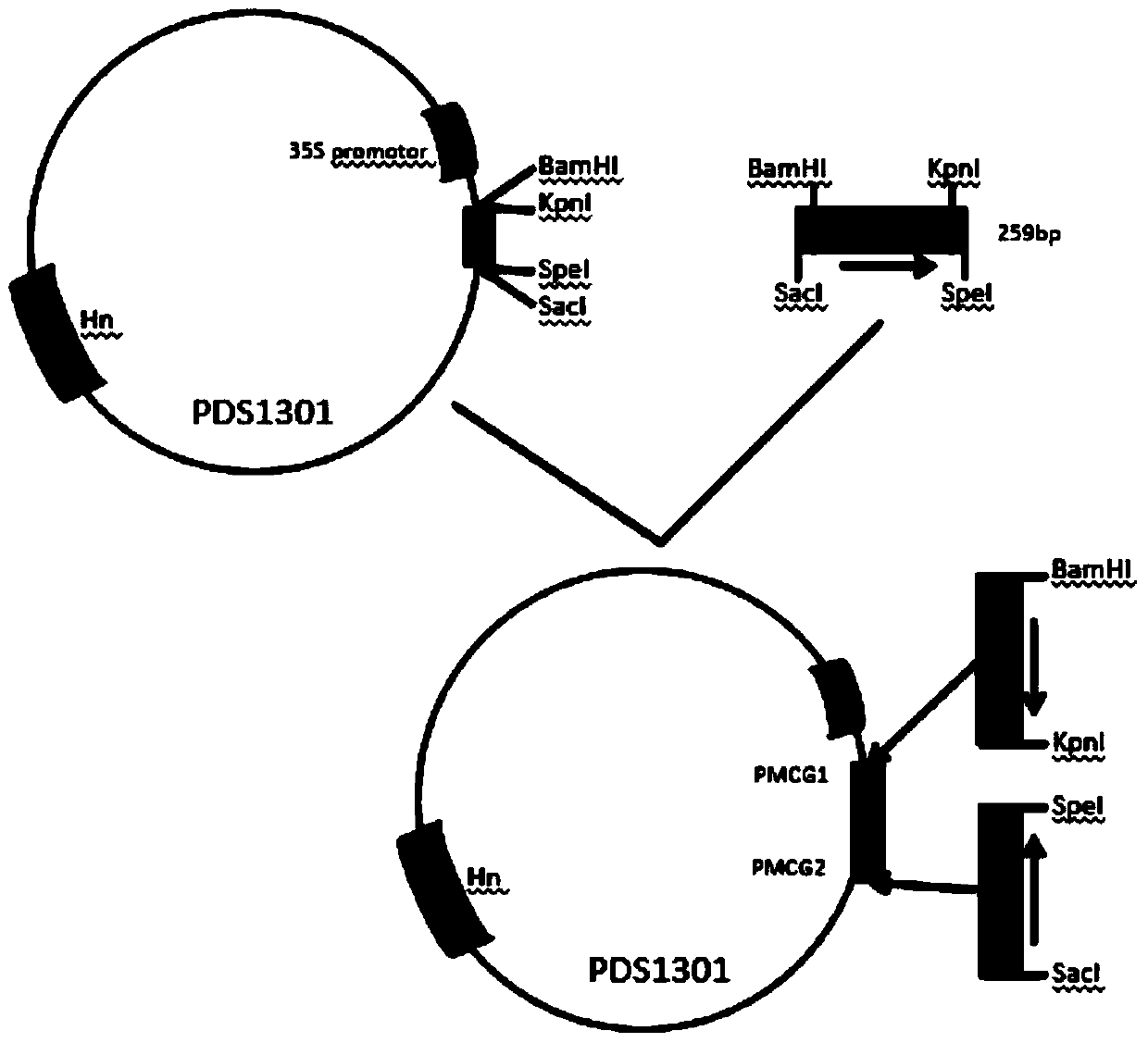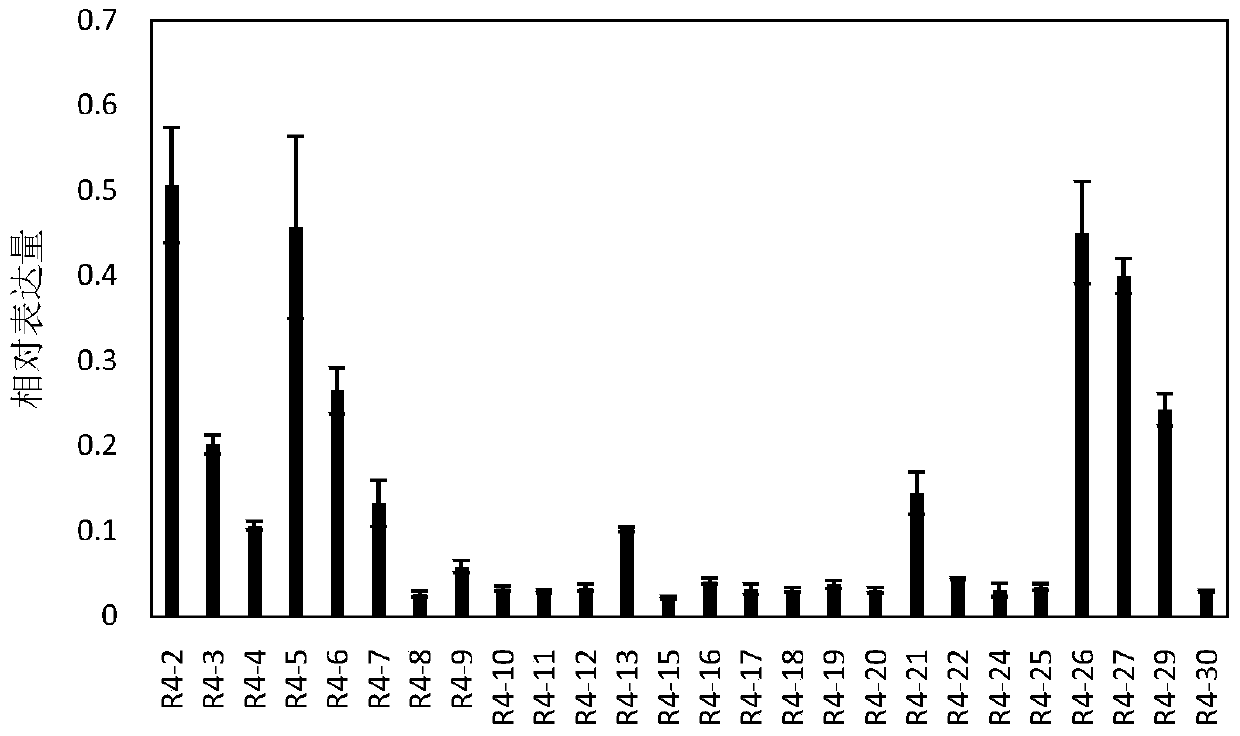Rice gene osein2l and its application
A gene and rice technology, applied in the fields of application, genetic engineering, plant gene improvement, etc., can solve the problem of no separation and cloning, and achieve the effect of promoting elongation
- Summary
- Abstract
- Description
- Claims
- Application Information
AI Technical Summary
Problems solved by technology
Method used
Image
Examples
Embodiment 1
[0038] Cloning of the gene OsEIN2L:
[0039]Pick the BAC (OSJNBb0024B16) of the rice variety Nipponbare (Nip), use LB medium containing 1‰ chloramphenicol to amplify, extract the BAC plasmid, use the BAC plasmid as a template, and use primers (the primer sequences are CATGATTACGAATTCGAGCTACGGATAAAGTATTTGATACTCCC and AACTCATGAAGGAACTATGGTGCAGAATTCACTCAAAAC) and primers (the primer sequence is GGATCCCCGGGTACCGAGCTAGTGGAGATTTCAGAAAGCC and CCATAGTTCCTTCATGAGTTCCTCTGAATGCCTTCTGCAGATGTTC synthesized by Wuhan Qingke) for polymerase chain reaction (PCR), PCR program: 94 ° C: 2min, 28 cycles (94 ° C: 15s, 68 ° C: 4min), will get The two PCR products were mixed 1 to 1 as templates, and then a new round of PCR was carried out with primers (primer sequences: CATGATTACGAATTCGAGCTACGGATAAAGTATTTGATACTCCC and GGATCCCCGGGTACCGAGCTAGTGGAGATTTCAGAAAGCC). The program was: 94°C: 2min, 25 cycles (94°C: 15s, 68°C: 5min30s ), the amplified product was sequenced to obtain the nucleotide sequence of t...
Embodiment 2
[0041] Construction of recombinant vector and establishment of transformed Agrobacterium:
[0042] according to figure 1 The technical route is to extract the DNA of the rice variety Nipponbare, and use the primer sequences (AAAGAGCTCGGATCCCCAGCGAGCTTTCTTTTGTTTCT and AAAACTAGTGGTACCCCTTTACAATGTTGCTGCTCCAG) to carry out polymerase chain reaction (PCR) to obtain a 259bp nucleotide fragment of OsEIN2L, the sequence is shown in SEQ ID No.4. PCR program: pre-denaturation at 94°C for 5 minutes; 35 cycles (denaturation at 94°C for 30 seconds; annealing at 62°C for 30 seconds; extension at 72°C for 30 seconds), and extension at 72°C for 7 minutes. The target fragment was first digested with BamHI and KpnI, and the target product was separated and recovered, and then ligated with the pDS1301 vector (Chu ZH et al., 2006) digested with BamHI and KpnI to form intermediate vector 1 with T4 ligase, and then the target fragment was Digested with SacI and SpeI, separated and recovered, ligat...
Embodiment 3
[0045] Agrobacterium-mediated genetic transformation:
[0046] (1), induction:
[0047] The seeds of mature rice varieties (Nihonbare, a japonica rice variety disclosed in China) were shelled, then treated with 70% ethanol by volume for 1 minute, and 0.15% concentration of mercuric chloride (HgCl 2 ) Disinfect the surface of the seeds for 15 minutes; wash the seeds 4-5 times with sterilized water; place the seeds on the japonica rice induction medium; place the inoculated medium in a dark place for 4 weeks at a temperature of 25±1°C.
[0048] (2), Succession:
[0049] Select bright yellow, compact and relatively dry embryogenic calli, and place them on the japonica rice subculture medium for 2-3 weeks in the dark at a temperature of 25±1°C.
[0050] (3), pre-cultivation:
[0051] Select compact and relatively dry embryogenic calli, put them on the japonica rice pre-medium and culture them in the dark for 4-5 days at a temperature of 25±1°C.
[0052] (4), Agrobacterium cult...
PUM
 Login to View More
Login to View More Abstract
Description
Claims
Application Information
 Login to View More
Login to View More - R&D
- Intellectual Property
- Life Sciences
- Materials
- Tech Scout
- Unparalleled Data Quality
- Higher Quality Content
- 60% Fewer Hallucinations
Browse by: Latest US Patents, China's latest patents, Technical Efficacy Thesaurus, Application Domain, Technology Topic, Popular Technical Reports.
© 2025 PatSnap. All rights reserved.Legal|Privacy policy|Modern Slavery Act Transparency Statement|Sitemap|About US| Contact US: help@patsnap.com



